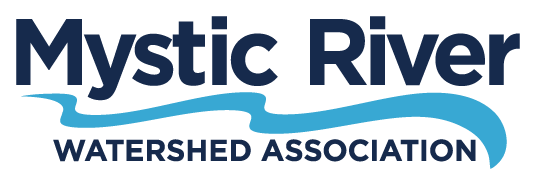The Mystic River Watershed Association strongly supports the EPA’s 2024 Draft Small Municipal Separate Storm Sewer Systems (MS4) General Permit. In particular, we support the targeted requirements calling for a 20% reduction in phosphorus discharges from municipal stormwater systems in the Mystic River watershed over six years.
A significant reduction in phosphorus – a pollutant found in stormwater runoff – would improve a number of water quality issues in the Mystic River and its tributaries, including overgrowth of invasive plants, toxic cyanobacteria blooms, and degradation of habitat for fish and other wildlife.
Cyanobacteria and algae bloom on the Mystic River, Medford, Summer 2017. Photo credit: Jack Bitney
MyRWA recently submitted a comment letter to the Environmental Protection Agency (EPA) sharing our support for the updated MS4 permit that regulates stormwater discharge from municipal stormwater systems. This Draft Permit expands on the requirements established in the 2016 MS4 general permit and includes pollution reduction requirements for MS4s that discharge to the Mystic River. These requirements, which call for a 20% reduction in phosphorus discharges from municipal stormwater systems over six years, represent a feasible, science-based, and much-needed step toward restoring and protecting water quality in our urban rivers and lakes in the Mystic watershed.
For over 50 years, MyRWA has worked with community members to better understand the risks to water quality in the Mystic River. We have partnered closely with US-EPA Region 1, the Massachusetts Department of Environmental Protection, and other agencies to measure water quality and investigate the negative impacts of excess nutrient pollution. Excess phosphorus in our waterways can limit public use, for example, restrictions due to obstructions from invasive plants. It also introduces public health threats from toxic cyanobacteria, halting boating and rowing recreation and affecting local businesses.
Significantly reducing nutrient pollution in the river, particularly phosphorus, is integral to achieving a healthy, safe, and resilient Mystic River in alignment with the Clean Water Act. Phosphorus loads from stormwater would have to be reduced by 60% to reach water quality targets. Like the recent CII General Permit, the MS4 permit represents necessary regulatory action toward this goal.
Cities change rivers, often for the worse. But we can change our cities in a way that helps rivers and creates sustainable urban spaces alongside thriving rivers for the enjoyment of all Americans. We urge EPA to adopt these new provisions for the Mystic as proposed and stand ready to assist municipalities in achieving them.
What Does the New Proposed Small MS4 Permit Require?
The new Small MS4 Permit would require municipalities in the Mystic River watershed to reduce phosphorus loads by 20% over the course of 6 years. Reduction on this scale is reasonable and attainable. Cities and towns in other watersheds, including the Charles River watershed, have made effective strides toward similar goals. Lessons from these communities—including Newton, Waltham, and Cambridge—offer a model that Mystic communities can adapt and benefit from.
There are many available solutions to reducing phosphorus in the Mystic River watershed, many of which are already underway in Mystic communities. Green infrastructure, like rain gardens, permeable pavement, and infiltration trenches, can remove phosphorus before it enters the system, and street sweeping can help remove debris before it gets flushed off the street. In addition, regulations on large public landowners like the CII General Permit go hand in hand with regulations placed on cities and towns.
Stormwater Pollution
Stormwater is another word for rain and melting snow. Stormwater pollution happens when the water picks up pollutants, flushing them down the nearest drain. Pollutants are then transported through underground pipe networks directly to our lakes, rivers, and streams.
One particularly impactful pollutant in stormwater is phosphorus, which comes from dead plants and leaves, fertilizer, and other organic waste and can lead to the growth of invasive plants and blooms of toxic cyanobacteria, which are dangerous for people and pets. Cities and towns have a critical role to play in limiting the amount of phosphorus that reaches the river through the stormwater pipe networks that they maintain.
For 50 years, the Mystic River Watershed Association has pursued a collaborative, science-based approach to fulfilling its mission of protecting and restoring the Mystic River, its tributaries, and green spaces in ways that protect public health and the public’s interests in recreational uses of and the ecological integrity of water bodies in the watershed. We support the MS4 Permit as a key tool for advancing that goal. Read the full comment letter below:












